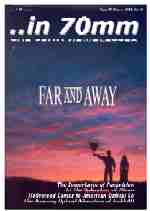4-track mag at the Egyptian
By Richard Greenhalgh
On
December 8, 2002, the American Cinematheque screened a very interesting
and unique piece of motion picture history, as a part of their excellent
4-Track Mag Stereo Film Festival, as they described in their announcement:
"4-Track Magnetic Stereo and Cinemascope Demonstration Film"
1953, 20th Century Fox, approx. 90 min. |
 Discoveries
from the "Around the World in 80 Days" Collection Discoveries
from the "Around the World in 80 Days" Collection
By Brian Tavers
The Library's “Around the World in 80 Days”
footage consists of 426 reels of picture and sound track
material, in several languages, in 16mm, 35mm and 70mm. |

•
Go to
Dust to Dust |
 The Passing of Bill Shaw The Passing of Bill Shaw
William C. Shaw, one
of the founders of IMAX Corporation, died on Saturday,
August 31 at age 73. Shaw died in a Toronto hospital after
suffering complications from a heart attack. Shaw joined
Graeme Ferguson, Roman Kroitor and Robert Kerr in 1968 to
design and develop the IMAX projection system. |
"Cinerama
Adventure" update
By Dave Strohmaier
The documentary is in Director's cut and is 100 minutes
long. A lot has changed since the early versions. We have
shown it around Los Angeles at several "test screenings" and
also at professional documentary film maker private
screenings to get some needed feedback. It's all on history
now with nothing on Bradford, Ohio or Seattle. |
"This is
Cinerama"'s Cinerama Dome
By Enthusiastic Cinerama Fans
On the evening of September 30, 1952 the feature-length travel log
"THIS IS CINERAMA" debuted. 50 years later, on October 4, 2002
it returns with a newly reconstructed print and seven-channel stereophonic
sound - presented in its ORIGINAL THREE-STRIP PROJECTION SYSTEM on the
huge, deeply-curved Cinerama Dome screen! |
70mm at the City Screen York
By Darren Briggs
Screens 1 and 2 are equipped with two projectors enabling changeover shows
to be performed for screening archive prints etc. Being a fan of 70mm and
large screen formats for many years, I wanted to
upgrade Screen 1 to 70mm as soon as I was given
the chance. In December 2001, after a
conversation with Tony Jones, he gave the go
ahead |
 Who is Greg Kimble? Who is Greg Kimble?
Greg Kimble is a classically trained visual effects supervisor with
credits dating back to the Special Edition of "Close Encounters". An
avid "Trekie," his first screen credit was on the original Star Trek
film, where he shot all the Klingon war birds and the V'ger craft. |
Restoration of “Patton”
by Michael
Pogorzelski |
Showscan enters liquidation process
by Greg Faris |
Canadian 70mm and Cinerama
screenings
by Bill Kretzel |
|
Willem
Bouwmeester
2002 member of the Academy of the Widescreen Weekend |
Wide Screen In LA, Fall 2002
by Bill Kallay |
"Cinerama
Adventure" in Telluride
by Dave Strohmaier |
Immersive Cinema Technologies Will
it Continue?
by Mark Andrew Job |
|
|
|
|
|
 An
Interview With Jim
Ward, V.P. of
Marketing, Lucasfilm,
Ltd. An
Interview With Jim
Ward, V.P. of
Marketing, Lucasfilm,
Ltd.
By Bill Kallay
Jedi Knights, Imperial Storm troopers and Tusken Raiders rejoiced this
past summer of 2002, when it was announced that "Star Wars:
Episode II-Attack of the Clones", would be released in the IMAX
format. For how many
years have fans of
the original
trilogy, and now
prequels, wished
upon the stars above
Skywalker Ranch for
the films to be
shown on the giant
IMAX screen? |
 Filming
of "Lewis and Clarke" in IMAX Filming
of "Lewis and Clarke" in IMAX
By Kurtis Burr
One of the biggest challenges in doing an IMAX film
about "Lewis and Clark" is trying to capture the
incredible scenery they would have experienced almost 200
years ago. |

•
Go to Cinerama's 50th
Anniversary |
 An
Interview With Roy
Conli, Producer of
"Treasure Planet" An
Interview With Roy
Conli, Producer of
"Treasure Planet"
By Bill Kallay
I came to Disney in
1993 and worked on
the development of "The
Hunchback of Notre Dame" and was co-producer on that film. I went
to France to run the French unit, and then ended up staying for three
years running the French studio, where I worked on the production of "Hercules"
(1997) and "Tarzan" (1999). And then I came back here
five years ago to produce this film. And previous to that, I was in the
theatre. |
"How the West Was
Won" screening at the Dome
by Richard Greenhalgh with Rick Mitchell |

•
Go to
"How The West Was
Won" - in Cinerama |
2002 LFCA
By Bill Kallay
Universal Studios, Imagine Entertainment and IMAX recently
unveiled their plans to re-release the 1995 film, "Apollo
13", in IMAX later this summer, re-titled as Apollo 13-The
IMAX Experience. The film went through IMAX's proprietary
software process, DMR, to enlarge and de-grain the Super
35mm images for presentation on the IMAX screen. In
addition, the 2.40:1 aspect ratio has been re-worked into
1.66:1. |
 The Lion King: The IMAX
Experience An Interview with Don Hahn The Lion King: The IMAX
Experience An Interview with Don Hahn
By Bill Kallay
My favorite
sequence in IMAX is when Mufasa's ghost shows up, Simba goes to the
reflecting pool, sees his reflection, and then all of the sudden, the
clouds form and Mufasa shows up. That's a stunning scene in IMAX. To see a six-story tall
apparition coming at you is very moving. |
|
|
|
|
|
| "IN 70MM.COM" NEWS |
|
2024,
2023,
2022,
2021,
2020,
2019,
2018,
2017,
2016,
2015,
2014,
2013,
2012,
2011, 2010,
2009, 2008,
2007, 2006,
2005, 2004,
2003,
2002,
2001,
2000,
1999,
1998,
1997,
1996,
1995,
1994 |
|
 26
Things Movies Taught You 26
Things Movies Taught You
By Bill Kallay
Rather than wasting bullets, megalomaniacs
prefer to kill their archenemies using complicated machinery involving
fuses, pulley systems, deadly gasses, lasers and man-eating sharks,
which will allow their captives
at least 20 minutes to escape. |
|
Halloween Movie Safety Tips |
|
 The 70mm Newsletter Issue 67 The 70mm Newsletter Issue 67 |
•
What is Todd-AO?
• "Baraka" cast and credits |
 The
Amazing Optical Adventures of Todd-AO The
Amazing Optical Adventures of Todd-AO
By Jeff Hecht
Todd had
just launched Cinerama, a wide-screen system that put the
audience in the middle of the action. Yet he knew the
cumbersome three-projector Cinerama system dated from before
World War II, and had split with his partners even before
the first Cinerama film opened. |
 Hollywood
Comes to American Optical Co. Hollywood
Comes to American Optical Co.
Roy C. Gunter Jr.
O'Brien was interested in what Todd said about Cinerama and sent Siegmund to New York to look at the system.
He reported back to O'Brien that while the optical system
was not really sophisticated, the audience response to the wide screen was
clearly favorable. |
 In the Splendour of 70mm In the Splendour of 70mm
By Grant Lobban
During the first few years of this century the wide gauge films were abandoned in favor of the smaller and more economical 35mm width. For example the Biograph
Company made its last 68mm subject in
1905 and in 1912 the 35mm Edison format
was internationally adopted as the
professional theatrical standard. |
  Die
Herrlichkeit von 70mm Die
Herrlichkeit von 70mm
Von Grant Lobban
In den ersten Jahren dieses
Jahrhunderts wurden Breitbildformat-Filme zu Gunsten der kleineren und
ökonomischeren 35mm-Breite aufgegeben. So stellte die Biograph Company
beispielsweise ihr letztes 68mm-Format 1905 her, bis 1912 war das
35mm-Edison-Format zum internationalen Standard der professionellen
Lichtspielhäuser geworden. |

• Go to
The Importance of
Panavision |
|
• Go to
in70mm.com News 2002
|
|
|
|
|
|